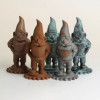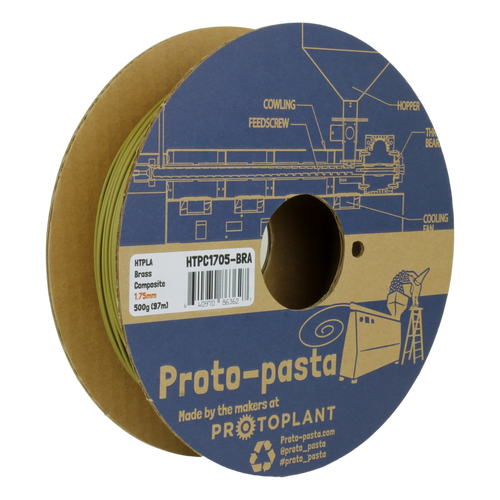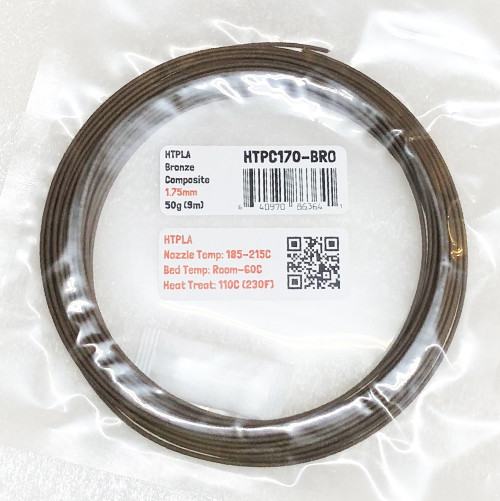- All material is sealed with desiccant in a plastic bag
- Usable on all PLA-compatible printers, such as Makerbot, Ultimaker, Printrbot, Lulzbot, and more!
- Prints with standard PLA settings - no heated bed or fancy hardware required
- Size: 1.75mm
- Weight: 500g
500 G of 1.75mm Proto-Pasta Copper Metal Composite HTPLA 3D Filament.
Terracotta or cast copper? Brush, polish, or patina and enjoy!
Introducing Copper Composite HTPLA. Prints like plastic, but finishes like real metal for beautiful, durable parts from most standard 3D printers. So many finishing possibilities, but here are some ideas to get you started (see sample Protognomes in product photos):
- Heat treat your HTPLA print to survive harsher environments like the hot sun or a warm polishing wheel (more details below)
- Wire Brush to expose metal for future oxidation or a bright, satin finish
- Rock tumble with steel shot for darker, but smooth, shiny look
- Paint part (black for example) to fill recesses with a contrasting color
- Polish with a rotary tool, cotton buff, and polishing compound for a bright, mirror finish on high spots (darkens low spots)
- Polish with paper for a clean, smooth, and bright finish with less darkening
- Patina (oxidize) exposed metal naturally or accelerate with a 50/50 vinegar/hydrogen peroxide mixture saturated with salt. Place in sealed plastic bag to retain moisture. Heat further accelerates reaction.
Now the only question is, "What will you make?"
Heat treating beforehand to firm up HTPLA helps parts hold shape up to near melting (175C). Protect your investment in warm environments or push limits of application by exploring copper's thermal conductivity. There is not enough copper to be electrically conductive, sintered, or plated, but there is a noticeable difference in weight and heat transfer.
Some application ideas include:
- Faux brick or clay
- Fixtures or hardware
- Knobs or buttons
- Heat sinks or exchangers
- Fine art & sculpture
- Emblems, signage, or trophies
- Jewelry, like pendants or bracelets
- Cosplay, game pieces, or figurines
Material data:
- Base resin: HTPLA - Heat Treatable PLA
- Additive: Real Copper Powder
- Particle size: less than 250 micron (0.25mm)
- Odor: low or no
- Density: 2.14 g/cc
- Length (500g): 97m (1.75mm) and 36m (2.85mm)
- Heat treating: 110C (225F) for 10 min or as required for desired result
- Total loss of stiffness (before heat treat): 50-60C (Tg)
- Total loss of stiffness (after heat treat): 150-175C (melting)
- Dimension change (before heat treat): 0% X/Y/Z
- Dimension change (after heat treat): 1.5% shrink X/Y and 1% growth Z typical but please calculate and confirm for your specific print and process
Printer settings:
- Speed: 10-20mm/s 1st layer, 30-120mm/s rest of part
- Nozzle Set-point: 185-215C (hottest on 1st layer for best adhesion)
- Nozzle Actual: maintain set-point, reduce speed if less than
- Nozzle Type: Standard or wear resistant for extended use
- Nozzle Diameter: 0.6mm or larger preferred, 0.4mm okay with 0.25mm minimum for experts
- Layer thickness: 0.15-0.20mm recommended for a balance of quality, reliability, and productivity
- Bed Temperature: Room-60C (over 60C can worsen warp)
- Bed Preparation: Elmers purple disappearing glue stick or your other favorite PLA surface preparation
This material has been flow optimized and has less moisture uptake than standard PLAs, however composites are still sometimes more tricky to print depending on hardware and software settings. The main challenge is to keep mass flow up (larger nozzle + fast speed) and in a single direction (minimal retraction) to avoid heat soak.












